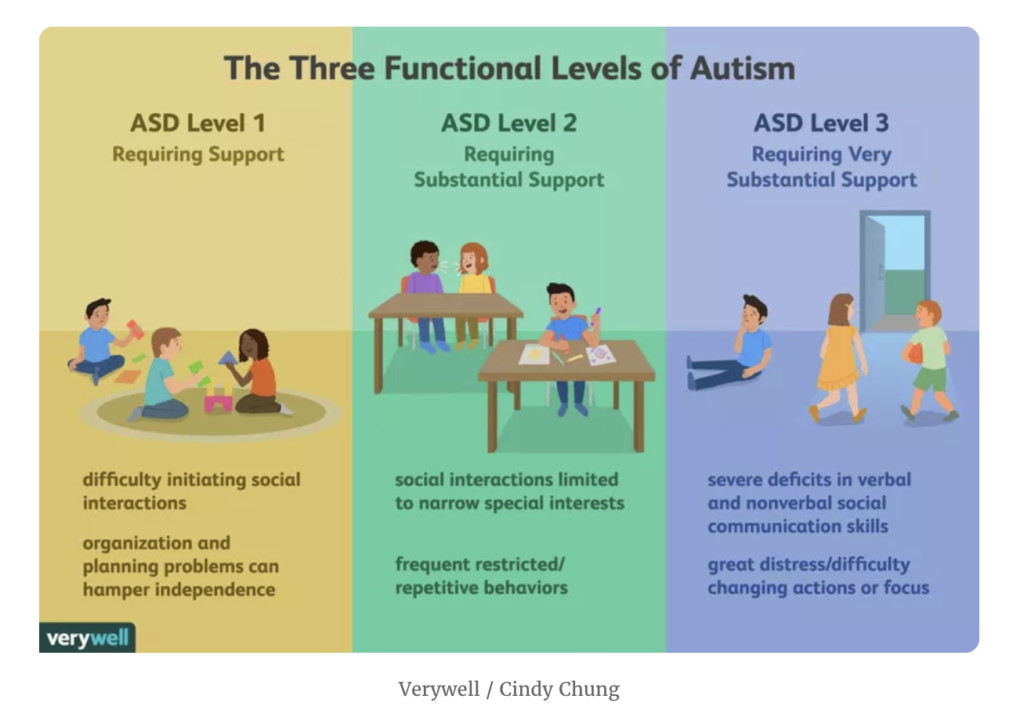Autism Spectrum Disorder (ASD) is a developmental disorder that affects how an individual interacts with and perceives the world and others, as well as how they express themselves. While each person with ASD is unique in their presentation of autism, the most common characteristics include challenges with speech, social interactions, and behavior.
Though autism is often viewed as a spectrum, doctors currently use a levels system when diagnosing a person as it provides a jumping-off point to help better understand those with autism and the various presentations they might have. This system, officially known as the Diagnostic and Statistical Manual of Mental Disorders (DSM-5), uses three levels of severity to categorize autism: Level 1 (mild), Level 2 (moderate), and Level 3 (severe).
What is the Difference Between Mild, Moderate, and Severe Autism?
While the DSM-5 makes it seem quite simple by breaking autism down into only three levels, it is important to understand that diagnosing autism can still be tricky. ASD characteristics and symptoms can vary greatly from one person to the next. Using the three levels of severity is merely a starting point.
After receiving an autism diagnosis, a doctor might provide even additional diagnoses or support according to the level initially presented. Further diagnosis will depend on how strong or severe symptoms are as well as the level of support the person may need to function day-to-day.
Level 1: Mild
Level 1, or mild autism, is also defined as “requiring support.” This simply means that an individual who is diagnosed as level 1 may face challenges that will require some form of support to function in social situations.
Symptoms or challenges someone with level 1 autism may face can include:
- Difficulties maintaining eye contact
- Difficulties reading body language or social cues
- Difficulties initiating conversations
- Problems making friends
- Troubles with responding as others would expect
- Difficulties maintaining interest in conversations
- Trouble with organization and planning
- Feeling uncomfortable with change, such as a new environment
Level 2: Moderate
A person who meets the level 2 criteria is defined as having moderate autism or “requiring substantial support.” Those who are diagnosed as level 2 may have significant difficulty communicating and interacting in social settings. Even with support, a person with moderate autism may still struggle to engage in ways that those without autism understand.
Symptoms and challenges faced by a person with level 2, moderate autism can include:
- Speaking in short sentences only
- Speaking infrequently
- Only discussing certain topics they are interested in or familiar with
- Difficulty expressing themselves nonverbally
- Difficulty understanding nonverbal communication
- Experiencing significant distress when change interrupts their daily routine
Level 3: Severe
This is the most severe form of autism. A person diagnosed with level three ASD will likely require very substantial support to function.
Challenges and symptoms faced at level 3 can include:
- Little to no verbal communication
- Only communicating via gestures and pictures
- Engaging in self-injurious behavior
- Aggressive outbursts
- Limited interaction with others
- No interest in friendship
- Repetitive behaviors
- Extreme difficulty dealing with changes in daily routine
- High levels of distress in situations that require them to change focus
- Difficulty with daily living activities, like taking care of their hygiene
What Is ABA Therapy, and How Can it Help?
There are many different therapies available for ASD, and using the three levels of autism for diagnosis can help medical providers determine which therapies are most appropriate based on the individual’s unique needs.
One such therapy that has shown great success and is most widely used and an evidence-based treatment is ABA therapy. ABA therapy can help kids and youth who are diagnosed at any level, but it is particularly beneficial for those who meet the criteria for level 3, severe autism.
ABA stands for Applied Behavior Analysis. It is a research and evidence-based approach that focuses on improving socially significant behaviors and has been recognized as the most effective treatment for ASD.
ABA therapy for kids with autism can help them learn new skills, communicate, improve their social interactions, and develop daily living skills. Overall, ABA is about helping children and youth with ASD better navigate their environment in a way that enables them to learn.
GBC ABA Therapy Services
At GBC Autism Services, our person-centered techniques and ABA therapy services can help turn your child’s goals into the best possible outcomes. We offer clinic-based and in-home therapy, as well as group sessions, school consultations, and intervention services. Our mission is to help children with ASD lead happy, independent, and fulfilled lives.
For more information on our ABA therapy services that may assist your child, contact our team today for a free consultation.




